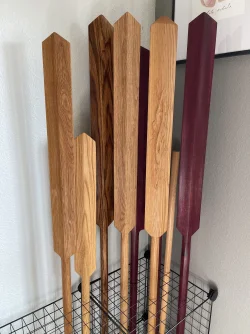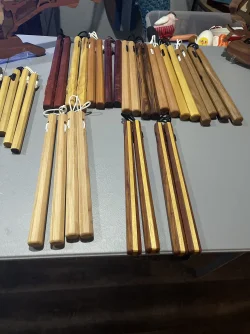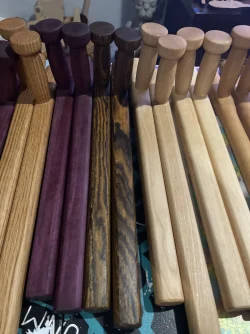Navigation
Install the app
How to install the app on iOS
Follow along with the video below to see how to install our site as a web app on your home screen.
Note: This feature may not be available in some browsers.
More options
Style variation
You are using an out of date browser. It may not display this or other websites correctly.
You should upgrade or use an alternative browser.
You should upgrade or use an alternative browser.
Kobudo weapon maker/seller
- Thread starter Gyuki
- Start date
Flying Crane
Sr. Grandmaster
What weapons are you looking for? I’ve made a few staff and spear shafts from hickory. It’s just something I do now and again in the yard.
I have used these guys... they are very good.

 kingfisherwoodworks.com
kingfisherwoodworks.com

Bokken, Jo and Related Wooden Weapons
Bokken, jo, bo, hanbo, and tanto for aikido, kendo, iaido, jodo and Japanese sword related martial arts and others including hiking sticks, self defense canes, and staffs all expertly crafted from the highest quality wood.
Gyuki
Yellow Belt
Specifically I would be looking for Tonfa. As the other person posted about Kingfisher, I have contacted them previously to see about a Tonfa with them yet have not had a reply. I imagine my request was irrelevant to them as they already have enough business otherwise and going out of their way for something if they barely have time to do what they have to is more then understandable.What weapons are you looking for? I’ve made a few staff and spear shafts from hickory. It’s just something I do now and again in the yard.
Seems like it is one of the more specific weapon so people may make less of them knowing that the best way to have a proper one is by taking measurements...
I am quite satisfied with my present Shureido, I simply wish to have another pair to use for contact training.
I have someone close by who claims to be able to make some as he made some previously and is starting his 2nd year of woodworking specifically in Kobudo. Having that said, I am still uncertain of exact proper wood to choose. So far hickory has been recommended as I live in Quebec so Red or White Oak is out of the question as they are sub par Oak, not Japanese Oak (which is formed differently), I have been told African Black wood as well as Hickory would be good choices... nevertheless, if I can find a maker with lots of experience that would be ideal
Thank you very much.
Ps-If it is a project that would interest you i can always PM you for details
If you are choosing a wood for paired practice, with decent weapon to weapon contact... I would go with Hickory. The Kingfisher site will go into more detail about why they choose hickory. The short answer is that it is the right combination of hard and flexible... it flexes just enough to not be brittle. There is a reason that when you go to the hardware store and look at the wooden handled hammers, axes, picks... they all have hickory handles.
Just google "hickory tonfa" Quite a few hits...
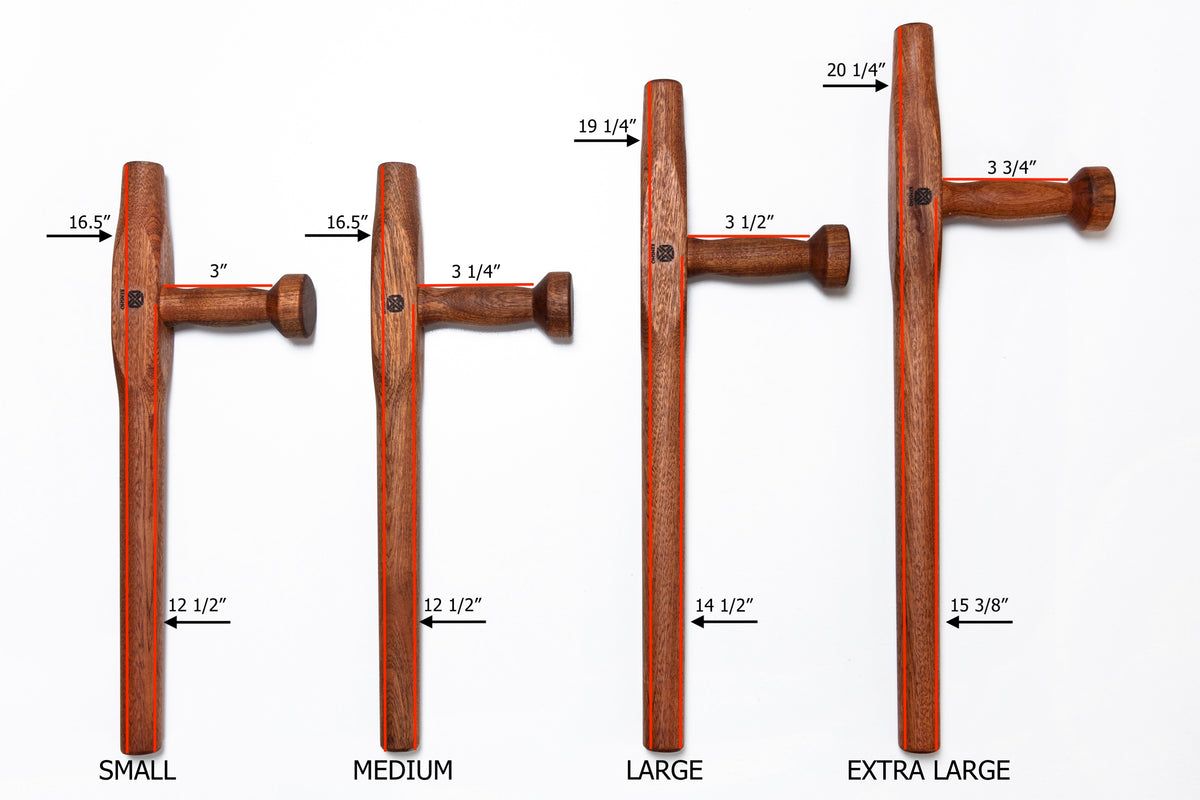
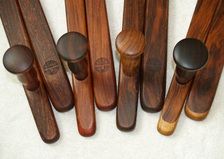
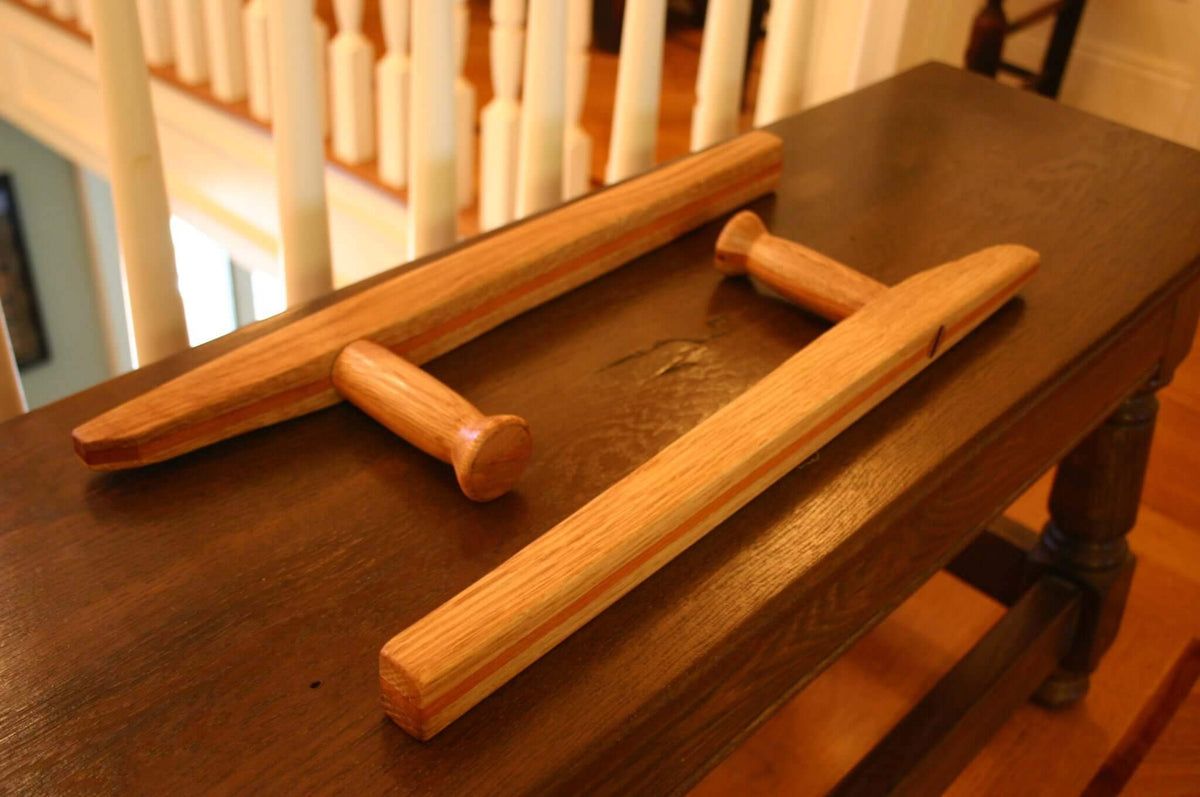

Tonfa
Kensho improved on the traditional Tonfa design to provide an ergonomically superior fit and Tonfa handle to Tonfa body connection. Customization options available for sizing and exotic wood preferences.
kensho.international

Gyuki
Yellow Belt
Thank you very much! I never tought of adding the actual word Hickory.... Guess I wanted to leave my options open for all types of woods.Just google "hickory tonfa" Quite a few hits...

Tonfa
Kensho improved on the traditional Tonfa design to provide an ergonomically superior fit and Tonfa handle to Tonfa body connection. Customization options available for sizing and exotic wood preferences.kensho.international


I am not the brightest sometimes lolol Thanks for this lightbulb moment.
Flying Crane
Sr. Grandmaster
Ive never done a tonfa and would hate to use your request as an experimentation. Not sure I could deliver on it. Good luck though.Specifically I would be looking for Tonfa. As the other person posted about Kingfisher, I have contacted them previously to see about a Tonfa with them yet have not had a reply. I imagine my request was irrelevant to them as they already have enough business otherwise and going out of their way for something if they barely have time to do what they have to is more then understandable.
Seems like it is one of the more specific weapon so people may make less of them knowing that the best way to have a proper one is by taking measurements...
I am quite satisfied with my present Shureido, I simply wish to have another pair to use for contact training.
I have someone close by who claims to be able to make some as he made some previously and is starting his 2nd year of woodworking specifically in Kobudo. Having that said, I am still uncertain of exact proper wood to choose. So far hickory has been recommended as I live in Quebec so Red or White Oak is out of the question as they are sub par Oak, not Japanese Oak (which is formed differently), I have been told African Black wood as well as Hickory would be good choices... nevertheless, if I can find a maker with lots of experience that would be ideal
Thank you very much.
Ps-If it is a project that would interest you i can always PM you for details
Staffs, spear shafts, sword hilts and sword scabbards are my thing.
Flying Crane
Sr. Grandmaster
I Believe part of the issue that makes hickory desireable for such uses is that when it breaks, the grain of the wood tends to hang on so that it breaks gradually, and does not simply fly apart all at once. That can be a big safety issue for tools like hammers and axes, and would be relevant for martial arts training as well.If you are choosing a wood for paired practice, with decent weapon to weapon contact... I would go with Hickory. The Kingfisher site will go into more detail about why they choose hickory. The short answer is that it is the right combination of hard and flexible... it flexes just enough to not be brittle. There is a reason that when you go to the hardware store and look at the wooden handled hammers, axes, picks... they all have hickory handles.
Gyuki
Yellow Belt
Absolutely agree on all those points.I Believe part of the issue that makes hickory desireable for such uses is that when it breaks, the grain of the wood tends to hang on so that it breaks gradually, and does not simply fly apart all at once. That can be a big safety issue for tools like hammers and axes, and would be relevant for martial arts training as well.
As a woodworker yourself, would you consider a wood that is not suitable for a Bokken for a Tonfa due to it's smaller size?
As an exemple, I have read somewhere that Sunuke was not suitable for Bokken for various reasons yet have seen the same wood being used for Nunchaku... I wonder if the size of the piece had an impact on such choice...
Excellent Woods « 武器用材木
www.zaimoku.org
Flying Crane
Sr. Grandmaster
Well, I should clarify that I am no expert and am more of a backyard dabbler, although I’ve managed to make some nice things. I’ve read a bit about woods, and have settled on what works well for my purposes and don’t know a whole lot about the others. There are some beautiful woods from around the world and it can be tempting to make weaponry with it. But there are a couple of issues. First, they can be expensive. Second, if they break all at once they they are not the best choice for impact weapons, although they does not automatically mean they are a terrible choice. They can still be strong wood, it’s just that IF they break, then they fly apart. But if the weapon is robust, they may not break. I believe baseball bats are made of maple. It is a strong wood, but as we see in nearly every pro game, they do break and they fly apart. But maple is a a strong wood, and it can be quite beautiful, especially if it has a curly grain. I don’t know why they don’t make baseball bats from hickory, but maybe there is something about hickory that make it wrong for baseball bats. I dunno.Absolutely agree on all those points.
As a woodworker yourself, would you consider a wood that is not suitable for a Bokken for a Tonfa due to it's smaller size?
As an exemple, I have read somewhere that Sunuke was not suitable for Bokken for various reasons yet have seen the same wood being used for Nunchaku... I wonder if the size of the piece had an impact on such choice...
this is what I have used as a reference for this. You may have a different opinion.... To be honest I am almost tempted to create a new thread for wood selection specifically...Excellent Woods « 武器用材木
www.zaimoku.org
The other thing is, some of the exotic woods are quite expensive. Do you want to spend a lot of money on a beautiful weapon that you plan to use for contact training, and it will eventually get battered and ugly and probably destroyed? Maybe a less expensive wood is a better choice if it holds up at least as well or better, and then the beauty of the wood should not be a consideration for such use.
Another issue that is more for the woodworker, is that a lot of the exotic hardwoods have natural oils that they produce as a defensive mechanism, that can cause nasty rash when working with it and being exposed to the sawdust. The finished and sealed wood is not a problem, but working it is when the woodworker can suffer. I discovered that I have sensitivities to at least some of those woods.
So I have personally settled on two woods that work well for my purposes. Hickory for things that may undergo impact, like staff and spear, and curly maple for sword grips and scabbards because it is strong, and can be quite beautiful and aren’t meant to be used for impact. These are native woods to North America and don’t have the allergic issues that the African and South American woods can have.
Actually, I keep some rattan staffs for impact training, because they are really cheap and they do not fly apart. They kind of gradually shred at the impact zone, and eventually when it is bad enough you throw it away and get a new one. I keep my hickory staffs for my forms work because it does take some effort to make them and I dont want to destroy them. They will get dented and rough if you are doing consistent impact training with them.
I don’t have a lathe to shape them. Instead, I cut a square dowel out of a hickory plank, and then shape it down by hand on a belt sander. It isn’t terribly efficient, and there are more irregularities than you would have with a professional grade lathe, but they are nice and they are clearly made by hand which is something that I appreciate.
Flying Crane
Sr. Grandmaster
I realize I didn’t really answer your question, about using a wood that isn’t a great choice for one type of weapon, for a different type. I think it is possible, but it depends. Something like tonfa is often braced along the underside of the forearm, and is short and could be fairly thick. For something like maple, perhaps that could work. Same with nunchaku, and back in the 1980s I used to see nunchaku advertised in Black Belt magazine, often made of “rock maple”. But my point really is, a longer weapon meant for impact is going to experience greater forces than a shorter weapon, all things being equal. That longer weapon is more likely to break than the shorter weapon of the material is prone to that kind of breaking.Absolutely agree on all those points.
As a woodworker yourself, would you consider a wood that is not suitable for a Bokken for a Tonfa due to it's smaller size?
As an exemple, I have read somewhere that Sunuke was not suitable for Bokken for various reasons yet have seen the same wood being used for Nunchaku... I wonder if the size of the piece had an impact on such choice...
this is what I have used as a reference for this. You may have a different opinion.... To be honest I am almost tempted to create a new thread for wood selection specifically...Excellent Woods « 武器用材木
www.zaimoku.org
In this same way, stainless steel is usually a bad choice for a sword because it can be brittle, but can be a good choice for a knife that will not be exposed to the same level of force that a sword will. Further, stainless is a good choice for surgical scalpels because rust on a tool used for surgery would be very dangerous. Stainless can hold a good sharp edge, so it is great for scalpels, great for knives especially if they will be used in a wet environment, but not so great for a sword.
isshinryuronin
Senior Master
I'll add Peter Carbone to the list you may be interested in. He is a karate and kobudo master, and studied weapon crafting in Okinawa. A number of masters there use his creations. Sai, tonfa and others. He is a one man operation and custom makes each piece. Warning - they are very high end, but beautiful works of art that are fully functional.
Kame kobudo
White Belt
Hi all,
We are a custom Kobudo weapons company out of Albuquerque NM. If anyone is looking for good Kobudo weapons we make them. For the past 4 years we have been making Bo, Jo, tambo, Tonfa, eku, Kama and nunchuku.
We are a custom Kobudo weapons company out of Albuquerque NM. If anyone is looking for good Kobudo weapons we make them. For the past 4 years we have been making Bo, Jo, tambo, Tonfa, eku, Kama and nunchuku.
Attachments
Kame kobudo
White Belt
Wood choices. Hickory is one of your best domestic durability wise. We use allot of exotic wood they hold up better but price can be considerable more. Let us know what you’re doing with them and we can steer you in the right direction for wood choices and pricing. There are some real hard Janka rated woods but the do have the flex, they work good for shot weapons but not long weapons. There’s allot to consider when choosing a wood type.
hoshin1600
Senior Master
So one aspect I didn't see anyone mention is vibration. I belive they use maple due to the vibration that is transfered into the hands. Maple reduces vibration as opposed to other hard woods. In general a harder wood gives more vibration. This can cause injury in the hands and arms. Hardwoods will tend to make your hands go numb during practice. This is also one reason white oak is the most common choice for impact weapons.I believe baseball bats are made of maple. It is a strong wood, but as we see in nearly every pro game, they do break and they fly apart. But maple is a a strong wood, and it can be quite beautiful, especially if it has a curly grain. I don’t know why they don’t make baseball bats from hickory, but maybe there is something about hickory that make it wrong for baseball bats. I dunno.
Weapons also need to have some give to them. I had a beautiful ebony bokken. Which my instructor accidentally cut in half with his, the first time i used it. Ebony is just to hard for impact. Hardness = brittle.
Last edited:
opr1945
Black Belt
Name or link would be useful. I didn't see any, but my tells me I am functionally blind.Hi all,
We are a custom Kobudo weapons company out of Albuquerque NM. If anyone is looking for good Kobudo weapons we make them. For the past 4 years we have been making Bo, Jo, tambo, Tonfa, eku, Kama and nunchuku.

